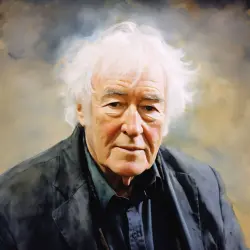Seamus Heaney’s ‘Had I not been awake‘ was written in the aftermath of a stroke suffered by the poet in 2006. The poem is a celebration of the energy and vitality of the natural world, which the narrator credits for giving him the necessary boost to keep going, both in the immediate context of his stroke and more broadly.
Before reading, it helps to know that Seamus Heaney wrote this poem during his recovery from a stroke. Keep in mind how something as simple as a gust of wind can feel meaningful after a serious health scare. The poem is calm, personal, and focused on how nature can suddenly pull someone back into awareness. It is not about big events, but about the small, quiet shifts that change how we see the world.
'Had I not been awake' Seamus HeaneyHad I not been awake I would have missed it,A wind that rose and whirled until the roofPattered with quick leaves off the sycamoreAnd got me up, the whole of me a-patter,Alive and ticking like an electric fence:(...)

Summary
In ‘Had I not been awake‘, Heaney brilliantly depicts the humming energy of life that surrounds us everyday, but we rarely have cause to notice.
The poem begins with an extension of the title, expressing the narrator’s gratitude for being awake as it meant he did not miss the ambiguous “it”. Much of the poem’s intrigue stems from what this thing may be. Heaney employs his typically evocative poetic eye to the natural world around the narrator, notably the wind and its sounds. As the poem continues, it becomes clear that the narrator draws strength and inspiration from the power of nature, which emboldens them to continue living.
Expert Commentary
Context
By the time ‘Had I not been awake‘ was published in Heaney’s 2010 collection, Human Chain, the poet was already celebrated throughout the world and was the 1995 winner of the Nobel Prize in Literature. Having launched his career with the acclaimed collection, Death of a Naturalist, in 1966, Heaney’s voice had become particularly resonant due to his poems and their relationship to The Troubles in Northern Ireland. ‘Had I not been awake‘ was conceived during Heaney’s recovery from a stroke he suffered in 2006, during which time he found the natural world to be especially affirming.
Detailed Analysis
Stanza One
Had I not been awake I would have missed it,
A wind that rose and whirled until the roof
Pattered with quick leaves off the sycamore
The opening line foreshadows the poem’s central theme, which is that of humanity’s relationship with the world around them, which they too often ignore. Whilst it is perfectly possible to read this line literally, it can also be a metaphor for the poet’s life if one interprets “awake” to mean alive. As an agnostic, Heaney did not believe in an afterlife, and the line, therefore, represents his acknowledgment that, if his life had ended, so would his ability to witness the beauty of the world.
The subsequent description of the wind, with all its speed and power, reminds the narrator that there is an energy that surrounds us all. It is this display of that energy that inspires the narrator to press on as the poem progresses. The onomatopoeic verbs “whirled” and “pattered” emphasize the narrator’s close proximity to the natural world.
Stanza Two
And got me up, the whole of me a-patter,
(…)
Had I not been awake I would have missed it,
The second stanza of ‘Had I not been awake‘ focuses on the narrator’s reaction to the wind, typified by the simile in the second line, which describes how he began “ticking like an electric fence.” This demonstrates how energized he was by the wind’s display of power. Furthermore, the use of the onomatopoeic verb “ticking” is crucial as, this time, it is applied to the narrator, which suggests a direct link between him and the natural world. The stanza ends with a refrain, which rounds off the first two stanzas, creating a degree of symmetry, potentially mirroring a complete electrical circuit.
Stanza Three
It came and went so unexpectedly
(…)
Returning like an animal to the house
This stanza once again refers to the mysterious “it” and details how fleetingly the moment passed. The unnamed object of Heaney’s interest could refer to the mysterious beauty of nature, which one can bear witness to and even engage with but never master or contain. It is this quality that inspired Heaney to keep living and to keep writing.
The use of the simile is significant as it likens nature to an animal but does not specify what kind. The fact it returns to the house implies a level of domestication, but this is juxtaposed by the adverb “dangerously” which suggests the animal is wild. This ambiguity could be a deliberate attempt to indicate that the ephemeral spark of inspiration is most likely to occur in the peripheral space between the human and natural worlds.
Stanza Four
A courier blast that there and then
(…)
After. And not now.
These final lines of ‘Had I not been awake‘ evoke the brevity of the wind’s impact, which quickly “lapsed” but still left its mark on the narrator. The use of caesura disrupts the pace of the stanza, just as Heaney’s life was interjected by setbacks after his stroke. The caesura also functions as a microcosmic representation of Heaney’s life after the stroke, as they are moments that resemble endings, yet the poem continues like Heaney continued living. Just as the wind’s gust was not “ever after,” Heaney knows he cannot live on in perpetuity. Whilst this may appear bleak, the stanza is actually intended to be affirming; the wind left a huge mark on the narrator but didn’t last forever. Heaney, therefore, challenges the readers’ perception of value and its relationship to permanence by implying that, while his remaining time on earth was finite, he was still capable of creating art and inspiring others.
FAQs
A courier is another word for a messenger or somebody that delivers goods. When used in this unusual context, it appears to suggest that the blast of wind was carrying something with it, perhaps the inspiration that Heaney was searching for.
Heaney was raised as a Catholic and attended Catholic school, but he later described himself as agnostic. He lived through the period known as The Troubles, which featured bouts of violence between Catholics and Protestants. In the context of this poem, Heaney’s personal beliefs are interesting as, while there is no explicit reference to a deity, the poem is imbued with a divine beauty that alludes to a higher power.
The poem is divided into four stanzas, the first two of which are neatly contained by the refrain on lines one and six. Curiously, the final stanza differs greatly from the others as the use of both enjambment and caesura ensures the lines are difficult to read with any flow as they are very disrupted. This could represent Heaney’s own life after the stroke, which was different to his life before but no less a part of his story.
Whilst the poem engages with the potentially downbeat subject matter, the tone is notably positive and hopeful. Its central message is that life, in spite of its fragility and brevity, has the potential to inspire and possess meanings that resonate long after it is over.
The “it” could simply refer to the gust of wind that inspired the narrator. However, it could also represent the intangible quality that nature possesses, which both fascinates and frightens us. Ultimately, like Heaney’s own life, the mysterious “it” lasts only a short time, yet it has ramifications that extend far and wide.
Similar Poetry
Readers who enjoyed ‘Had I not been awake‘ might want to explore more of Seamus Heaney’s poetry. For example:
- ‘A Drink of Water‘ – Taken from his 1979 collection, “Field Work“, Heaney again uses the natural world to frame his musings on life.
- ‘Personal Helicon‘ – Another poem that exists in the liminal space where human life meets the natural world.
Some other poems which might be of interest include:
- ‘And Soul‘ by Eavan Boland – A contemporary of Heaney, Boland’s poem brilliantly describes a human body’s dissolution into the elements that form it.
- ‘World I Have Not Made‘ by Elizabeth Jennings – A fascinating exploration of creation and the individual’s relationship to the world around them.

















